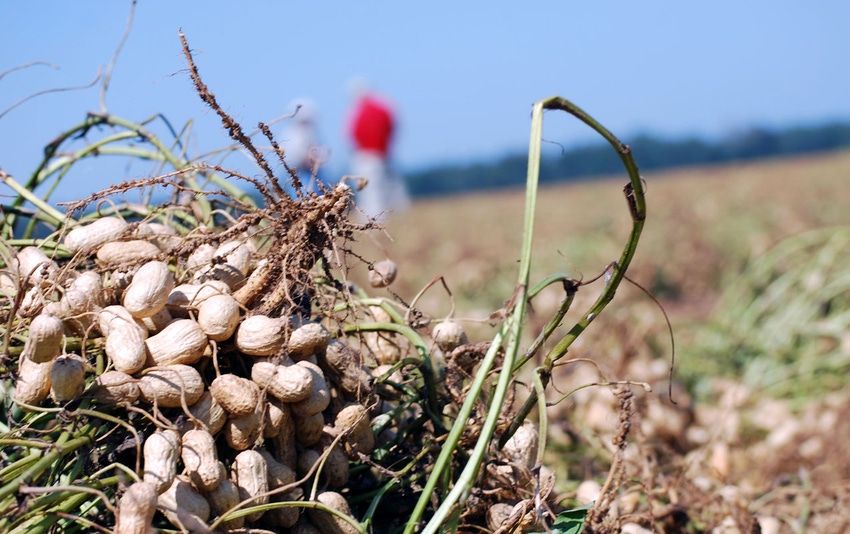March 5, 2014

When producing large-seeded peanuts, you don’t necessarily need more calcium more often, but calcium does take on a new significance. Without it you end up with pops and black heart or other problems.
“Peanuts fix nitrogen, and they’re good scavengers of P and K,” says Glen Harris, University of Georgia Cooperative Extension agronomist. “When it comes to fertilizing peanuts, it all comes down to calcium. And, you have to have soluble calcium right in that pegging zone, in the top 3 inches. You have to dissolve the calcium and get it into the peanut.”
You can have all the calcium in the world in that top 3 inches, he says, but if you don’t have the water to dissolve the calcium and get it to the peanut, then you’ll have problems, problems such as pops, pod rot and black heart.
“Calcium also is critical for the germination of peanut seed, so any peanuts grown for seed still have an automatic recommendation – 1,000 pounds of gypsum at bloomtime regardless of how high calcium levels might be. We’ve had questions over the years about whether you still need to put it on, and yes, you do – it’s that important. It might be like insurance, but it’s not something to take a chance on,” says Harris.
If you’re not growing peanuts for seed, the standard recommendation calls for additional calcium when levels are less than 500 pounds per acre, unless the calcium to potassium ratio is less than 3:1.
When peanut producers began shifting from small-seeded to large-seeded peanut varieties, researchers began taking a closer look at calcium rates. And, after three years of data and 14 sites in Georgia and Alabama, it has been determined that large-seeded peanuts don’t need more calcium or that they need it more often. It’s just more important, he adds.
“We really thought we’d have to change our Extension recommendations, but we did not – they still hold. But we were getting away with some things on Georgia Green that we can’t get away with on a large-seeded peanut like Georgia-06G. And if the day comes when we shift back to a smaller seed, we’ll obviously still be good with our recommendations.”
With recommendations staying as they are, there’s more discussion about source and timing when it comes to supplying calcium to peanuts, says Harris.
“It might first appear to be pretty simple when it comes to gypsum. But now we have lime, which came on board about 15 years ago, and we’re looking at putting out calcium chloride through the pivot. Basically, if you look at all of these sources and how to use them, it all comes back to solubility," he said.
There’s also a tendency to forget that soil-test calcium is a source, says Harris. “It’s the least soluble of the sources. That’s why if you’re not growing peanuts for seed, as long as you have more than 500 pounds of soil-test calcium in the pegging zone, especially on irrigated land, you’re probably not going to see a response to gypsum. But you might want to put it on as insurance.”
The calcium in lime is less soluble than calcium sulfate or gypsum, says Harris.
“And that is why is you’re using the lime method – because you need to put it on at planting. If you wait until bloomtime, it won’t be soluble enough to get the calcium into the peanut. That is also why we can use gypsum at bloomtime or about 35 days after planting.”
About three years ago, Harris and other researchers began looking at calcium chloride and calcium thiosulfate. These clear-liquid calcium fertilizers are basically 100-percent soluble.
“We should put these on when peanuts are really taking in calcium, so we’re talking 60 to 90 days after planting. In our research, we put out these materials through the pivot at about 75 days after planting. They’re not as good as gypsum, and they don’t bring levels up as high. But they do get more calcium into the nut. Calcium thiosulfate is half as concentrated as calcium chloride and costs about twice as much. So, from a cost-standpoint, you’d probably lean towards calcium chloride.”
Differences within differences
Also, there are differences within the different sources of gypsum.
“For example, with lime you have calcitic lime and dolomitic lime, fine lime and regular ground lime. There’s also a very fine liquid lime that’ll go through a regular sprayer. We’re simulating putting that out through a pivot," he said.
Harris says growers, especially in southwest Georgia, seem to be more willing to put out fertilizer – for peanuts, cotton and corn – through a center pivot, and research if focusing on that trend.
There are also several different kinds of gypsum, he says, and new ones are constantly coming onto the market.
“Right now, most of our standard recommendations have not changed. I do feel comfortable with liquid calcium through the pivot. I don’t think they replace calcium, but I think they have a fit in situations where you’re borderline and not sure you have enough.
“In 2013, weather conditions were extremely wet, and we couldn’t get into the fields with gypsum spreaders, so some growers put out some through pivots. We have some options, and half the battle is just making sure you’ve got enough calcium in the pegging zone – that’s the first rule.”
About the Author(s)
You May Also Like




